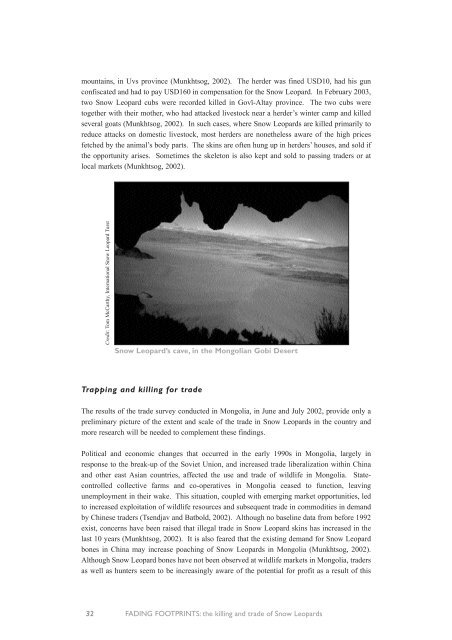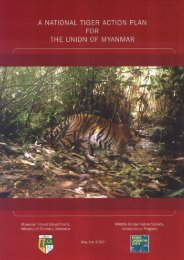Download - Global Tiger Initiative
Download - Global Tiger Initiative
Download - Global Tiger Initiative
Create successful ePaper yourself
Turn your PDF publications into a flip-book with our unique Google optimized e-Paper software.
mountains, in Uvs province (Munkhtsog, 2002). The herder was fined USD10, had his gun<br />
confiscated and had to pay USD160 in compensation for the Snow Leopard. In February 2003,<br />
two Snow Leopard cubs were recorded killed in Govï-Altay province. The two cubs were<br />
together with their mother, who had attacked livestock near a herder’s winter camp and killed<br />
several goats (Munkhtsog, 2002). In such cases, where Snow Leopards are killed primarily to<br />
reduce attacks on domestic livestock, most herders are nonetheless aware of the high prices<br />
fetched by the animal’s body parts. The skins are often hung up in herders’ houses, and sold if<br />
the opportunity arises. Sometimes the skeleton is also kept and sold to passing traders or at<br />
local markets (Munkhtsog, 2002).<br />
Credit: Tom McCarthy, International Snow Leopard Turst<br />
Snow Leopard’s cave, in the Mongolian Gobi Desert<br />
Trapping and killing for trade<br />
The results of the trade survey conducted in Mongolia, in June and July 2002, provide only a<br />
preliminary picture of the extent and scale of the trade in Snow Leopards in the country and<br />
more research will be needed to complement these findings.<br />
Political and economic changes that occurred in the early 1990s in Mongolia, largely in<br />
response to the break-up of the Soviet Union, and increased trade liberalization within China<br />
and other east Asian countries, affected the use and trade of wildlife in Mongolia. Statecontrolled<br />
collective farms and co-operatives in Mongolia ceased to function, leaving<br />
unemployment in their wake. This situation, coupled with emerging market opportunities, led<br />
to increased exploitation of wildlife resources and subsequent trade in commodities in demand<br />
by Chinese traders (Tsendjav and Batbold, 2002). Although no baseline data from before 1992<br />
exist, concerns have been raised that illegal trade in Snow Leopard skins has increased in the<br />
last 10 years (Munkhtsog, 2002). It is also feared that the existing demand for Snow Leopard<br />
bones in China may increase poaching of Snow Leopards in Mongolia (Munkhtsog, 2002).<br />
Although Snow Leopard bones have not been observed at wildlife markets in Mongolia, traders<br />
as well as hunters seem to be increasingly aware of the potential for profit as a result of this<br />
32 FADING FOOTPRINTS: the killing and trade of Snow Leopards

















